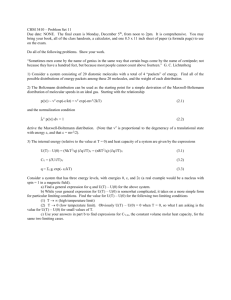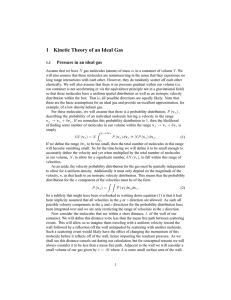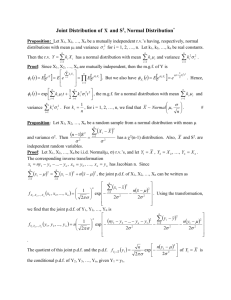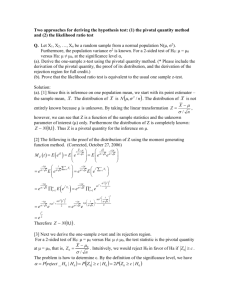Lecture 17
advertisement
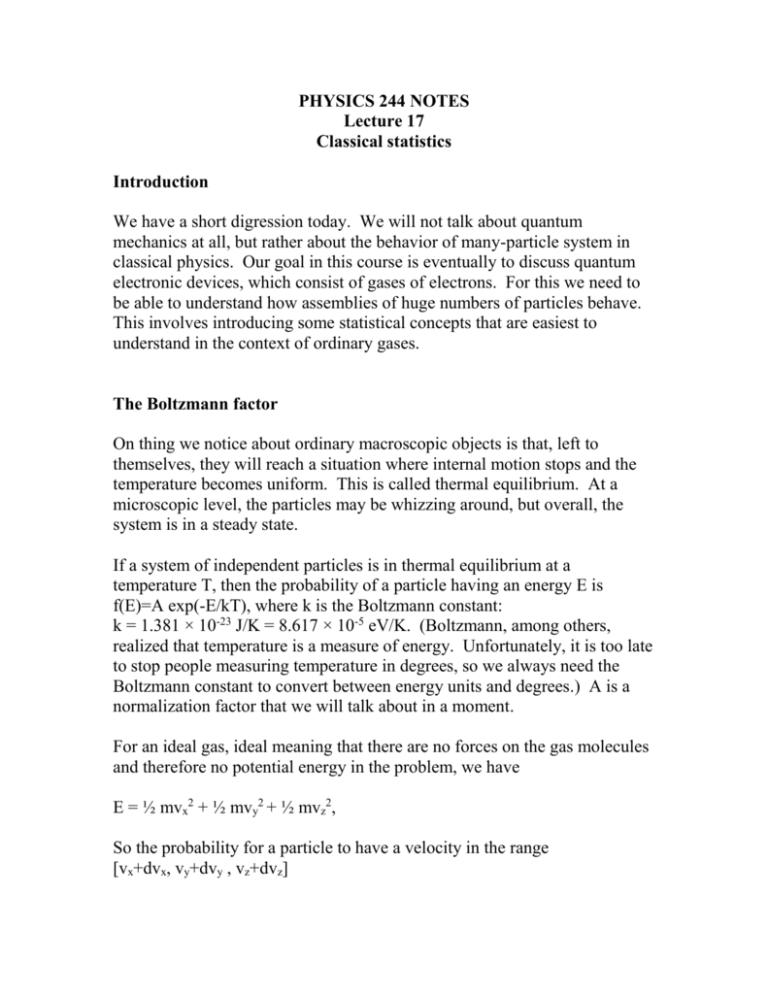
PHYSICS 244 NOTES
Lecture 17
Classical statistics
Introduction
We have a short digression today. We will not talk about quantum
mechanics at all, but rather about the behavior of many-particle system in
classical physics. Our goal in this course is eventually to discuss quantum
electronic devices, which consist of gases of electrons. For this we need to
be able to understand how assemblies of huge numbers of particles behave.
This involves introducing some statistical concepts that are easiest to
understand in the context of ordinary gases.
The Boltzmann factor
On thing we notice about ordinary macroscopic objects is that, left to
themselves, they will reach a situation where internal motion stops and the
temperature becomes uniform. This is called thermal equilibrium. At a
microscopic level, the particles may be whizzing around, but overall, the
system is in a steady state.
If a system of independent particles is in thermal equilibrium at a
temperature T, then the probability of a particle having an energy E is
f(E)=A exp(-E/kT), where k is the Boltzmann constant:
k = 1.381 × 10-23 J/K = 8.617 × 10-5 eV/K. (Boltzmann, among others,
realized that temperature is a measure of energy. Unfortunately, it is too late
to stop people measuring temperature in degrees, so we always need the
Boltzmann constant to convert between energy units and degrees.) A is a
normalization factor that we will talk about in a moment.
For an ideal gas, ideal meaning that there are no forces on the gas molecules
and therefore no potential energy in the problem, we have
E = ½ mvx2 + ½ mvy2 + ½ mvz2,
So the probability for a particle to have a velocity in the range
[vx+dvx, vy+dvy , vz+dvz]
f(vx,vy,vz) = A exp [-(m/2kT) (vx2 + vy2 + vz2)] dvx, dvy, dvz.
What this says is that the typical kinetic energy for a molecule in a gas is
about kT, and that the chance that it is very much greater than that is quite
small. Let us make these statements more quantitative.
The normalization factor is determined by the statement that the total
probability is equal to one:
1 = A ∫∫∫ dvx dvy dvz exp [-(m/2kT) (vx2 + vy2 + vz2)]
= A ∫∫∫ dvx dvy dvz exp [-(m/2kT) (vx2 + vy2 + vz2)]
so
1/A = ∫dvx exp [-(m/2kT) (vx2)] ∫ dvy exp [-(m/2kT) (vy2 )] ×
∫ dvz exp [-(m/2kT) (vz2)]
= { ∫dvx exp [-(m/2kT) (vx2)] }3,
using the properties of the exponential. Now we need some integrals
∫exp(-λx2) dx = (π/λ)1/2.
∫x exp(-λx2) dx = 0.
∫x2 exp(-λx2) dx = ½ (π/λ3)1/2.
Now we recognize our integral as the first one with λ = m/2kT.
1/A = [(2πkT/m)1/2]3 = (2πkT/m)3/2 and A = (m/2πkT)3/2, so
f(vx,vy,vz) = (m/2πkT)3/2exp [-(m/2kT) (vx2 + vy2 + vz2)].
We can now calculate the average x-component of velocity as
< vx > = (m/2πkT)3/2 ×
∫∫∫ dvx dvy dvz vx exp [-(m/2kT) (vx2 + vy2 + vz2)] =0,
and the average squared x-component of velocity as
< v2x > = (m/2πkT)3/2 ×
∫∫∫ dvx dvy dvz v2x exp [-(m/2kT) (vx2 + vy2 + vz2)]
= (m/2πkT)3/2 ×
∫∫∫ dvx dvy dvz v2x exp [-(m vx2/2kT)]
× exp [-(m vy2/2kT) (vy2)] exp [-(m vz2/2kT)]
= (m/2πkT)3/2 ×
∫ dvx v2x exp [-(m vx2/2kT)] (2πkT/m)1/2 (2πkT/m)1/2
= (m/2πkT)1/2 (2kT/m)3/2 ∫ du u2 exp -(u2)
= (2kT/m) π-1/2 (½) π1/2
= kT/m.
This is an example of the equipartition principle, which is that a quadratic
degree of freedom contains kT/2 of energy:
< ½ m v2x > = ½ m (kT/m) = kT/2.
The root-mean-square velocity is
vrms = < v2 >1/2 = < v2x + v2y + v2z > ½ = (3kT/m)1/2.
For N2 at 300 K, we have
vrms = (3 × 1.38 × 10-23 J/K × 300 K / 14 × 1.66 × 10-27 kg)1/2
= 1.68 × 103 m / s
= 3700 mi/hr.
Law of atmospheres, or How high is the sky?
The Boltzmann factor applies to the potential energy as well as the kinetic
energy. In the atmosphere, as opposed to the gas in a room, the change in
gravitational potential energy my be comparable to kT. Assuming, rather
crudely, that the atmosphere is isothermal, we have
f(h) = A exp (-mgh/kT), and A is obtained from
1/A = ∫dh exp (-mgh/kT) = kT/mg, so A = mg/kT and
f(h) = mg/kT exp (-mgh/kT).
The average height for the molecule is
< h > = mg/kT ∫dh h exp (-mgh/kT) = kT/mg.
For N2 at 300K, we find
< h > = 1.38 × 10-23 J/K 300K / (28 × 1.66 × 10-27 kg × 9.8m/s2)
= 8500 m.
The top of Mount Everest is at 8900 m above sea level.
This tells us that the density ρof the atmosphere falls exponentially
according to the function ρ(h) = (mg/kT) exp(-h/8500m). At the top of
Everest, the atmosphere is roughly 1/e as dense as at sea level.
There is no top of the atmosphere – it just fades away.

